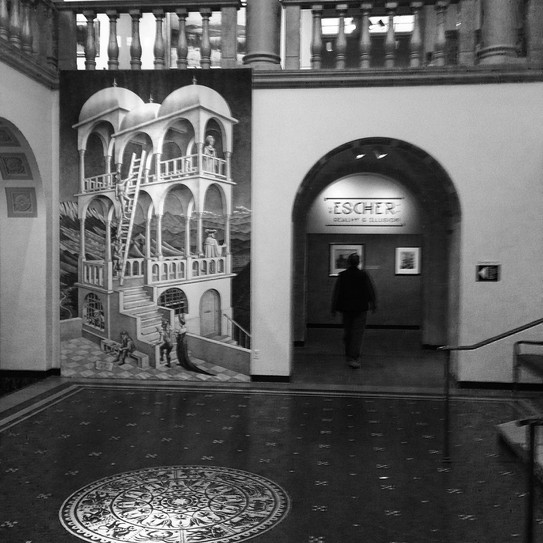Escher at the Currier

The entrance and exit to “M.C. Escher: Reality and Illusion” at the Currier Museum of Art through Jan. 5. Photo by J.L. Stevens
“Only those who attempt the absurd will achieve the impossible. I think it’s in my basement… let me go upstairs and check.” – M. C. Escher
Ah, Escher — the man known for his impossibly wonderful, wonderfully impossible drawings and prints. He’s a man, as the director and CEO of the Currier Museum of Art, Susan Strickler says, “whose works are instantly recognizable, but whose first name is less well known.” The works of “M.C. (Maurits Cornelis) Escher: Reality and Illusion” exhibit is on display through Jan. 5 at the Manchester museum. And it is well worth the 45 minute drive from the Seacoast.
Granted the exhibit is highly visual, and that is only enhanced by the supply of magnifying glasses stationed at points throughout. There’s something about having a magnifying glass in your hand that makes you feel like a detective, a detective on the hunt for what it must have felt like to draw the tesselations and geometrically impossible works in each piece. (Pointer: If you don’t see a magnifying glass at the beginning, hustle to the end and grab one from the return station. They’re popular.)
While many are fond of Escher’s pieces, architects must hold them in a special chamber of their heart. Escher was, after all, a failed architect: “In 1919, Escher attended the Haarlem School of Architecture and Decorative Arts in Haarlem. He briefly studied architecture, but he failed a number of subjects (partly due to a persistent skin infection) and switched to decorative arts,” we’re told. And, fortunately so, that’s where he learned his drawing skills, and how to make woodcuts.
At least twice in the exhibit, you will see a placard with the words “Eigen Druk” on it. It translates to “By my own hand,” and Escher added it to the bottom of many pieces. You see, it took years to be a skilled printer, and Escher was very proud of this fact.
Marvel at “Metamorphosis II,” 1939-40, a monumental woodcut printed from 20 blocks on three combined sheets in black, green and brown. The piece combines tesselations with metamorphosis for dramatic storytelling using multiple themes. Wonderfully described, “words become shapes, shapes become creatures, and cubes become a chessboard landscape resolving into words and thus, we end where we began.”
You will definitely recognize “Drawing Hands,” 1948, lithograph. Escher was left handed and used his right hand as a model. It’s definitely one of his more well-known pieces.
Less well known is “Tetradedral Planetoid,” 1954, a woodcut in green and black. (Photographs were not allowed of the exhibit, but a quick visit to WikiArt, the Visual Art Encyclopedia will show you all you need to know.) If that isn’t enough architecture for you, “Double Planetoid,” 1949, a wood engraving, is mounted right next to it. Cities seem to spring from each and every compass point.
Escher was not content to merely replicate life as he saw it (or life as he saw it was very different than how ordinary folks saw it.)
In “Path of Life III,” 1966, a woodcut, you see a study of infinity. Escher tries to achieve infinite smallness in the center of the work. Does he succeed?
The Currier does a nice job of providing ways for you to put yourself into exhibits. In the Escher exhibit, this involves making your own self-portrait (a la his “Self-Portrait in Spherical Mirror,” 1950, woodcut.) In the gallery, you are invited to sit at a table and gaze into a silver gazing ball and draw what you see, or don’t see. You then clip it to a wall already full of previous patrons pencil drawings. It’s a trip to imagine you are an artist, and the subject simultaneously, and yet also just one of the many passing through this somewhat otherworldly show.
Another great feature of the Currier’s Escher exhibit is the entrance and exit wall. It is a giant wall-sized print of “Belvedere,” 1958, a lithograph that is also in the exhibit. Walk through the arch next to this piece that in itself contains at least 20 archs, and feel at once viewer and part of the show.
WHAT “M.C. Escher: Reality and Illusion”
WHEN through Monday, Jan. 5, 2015
WHERE Currier Museum of Art, 150 Ash St., Manchester, N.H.
COST $5 special exhibition charge to view; Saturdays, 10 a.m.-2 p.m., free admission for N.H. residents
CONTACT 669-6144, www.currier.org


